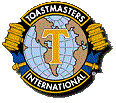
District #65 Area #4 Club #6898
Communicating With Confidence
| Home |
| Why Join? |
| Meeting Calendar |
| Driving Directions |
| Toastmasters FAQ |
| Club History |
| Officers |
| Meeting Structure |
| Manuals |
| Newsletters |
| Links |
| Public Speaking Tips |
| Contact Us |
| Members Only Area |
Speech ManualsToastmasters International has developed speech manuals specifically designed to help you first learn the basics of speech preparation, then progressing to learn specific types of speeches suited to your own desires. When you join Toastmasters you will receive your first manual "Communication and Leadership Program", also referred to as the "Basic Manual". When you finish this manual you will have reached the level of CTM (Competent Toastmaster). From there you will start using the advanced manuals that are designed to cover more specific types of speeches. When you finish two of these manuals you have reached the first ATM (Advanced Toastmaster) level. As you continue using the advanced manuals, as well as fulfilling other requirements, you will receive further awards. More importantly, though, you will become a better communicator both in your professional and personal life. Basic ManualCommunication and Leadership Program Basic Manual (225)This is the manual that all Toastmasters start with. The ten speeches are designed to provide the basic tools towards becoming an effective speaker. Upon finishing this manual, the Toastmaster receives the Competent Toastmaster (CTM) award.
Advanced ManualsEach manual is $3.00. Charts are also available to track your accomplishments and those of your fellow Club membersThe Entertaining Speaker (226-A)This manual includes valuable information on how to give an entertaining or dramatic speech, where to find material, how to make an audience laugh, and what to do when you're asked to speak after dinner.
Speaking To Inform (22G-B)The projects in this manual will help you give informative and interesting speeches. Topics covered include the demonstration talk, the fact-finding report, the abstract concept, and resources for informing.
Public Relations (226-C)This complete guide to preparing and delivering the public relations speech will help you develop resources and techniques, "speak under fire," and handle the media talk. The Discussion Leader (226-D)This manual offers guidance in presenting workshop and conference presentations. Role-playing and problem-solving sessions are also covered. This manual is a must for managers, trainers, teachers, and administrators.
Specialty Speeches (226- E)Speakers must be able to speak in many situations and this manual will help. Types of speeches covered include impromptu speeches, sales presentations, introductions, inspirational speeches, and oral interpretations.
Speeches by Management (226-F)This manual will help you successfully handle a variety of speaking situations managers encounter in their work environments. Subjects covered include briefings, technical speeches, motivational talks, and confrontations.
The Professional Speaker (226-G)This manual is a complete guide to becoming a professional speaker. Subjects covered include speaking as a company representative and speaking for pay.
Technical Presentations (226-H)The projects in this manual will help you prepare and present briefings, proposals, technical papers, and technical team presentations.
Persuasive Speaking (226-I)The projects in this manual will help you sell products, services and ideas to others.
Communicating on Television (226- J)Television presentations differ from other presentations, and they require special considerations. With this manual you'll learn to present editorials, appear as a guest on a "talk" show, conduct a press conference, and use television to train.
Storytelling (226-K)Everyone loves a story. Types of stories covered in this manual include the folk tale, the personal story, stories with morals, the touching story, and the historical story. Interpretive Reading (226- L)This manual will help you develop your interpretive reading skills. The projects include presenting stories, poetry, monodramas, plays and oratorical speeches.
Interpersonal Communications (226-M)Topics covered include conversing with ease, negotiating, handling criticism, coaching someone to improved performance, and expressing dissatisfaction effectively.
Special Occasion Speeches (226-N)Provides instruction in giving toasts, speaking in praise, "roasting" someone, and presenting and accepting awards.
Humorously Speaking (226-O)Audiences love to laugh. This manual shows you how to use humorous stories and jokes throughout your speech to grab and keep listeners' attention and illustrate your points. You also learn how to give an entirely humorous speech.
|
|
The names "Toastmasters
International", "Toastmasters", and the Toastmasters International
emblem are trademarks protected in the United States, Canada, and
other countries where Toastmasters Clubs exist. Unauthorized use is
prohibited. Frederick Douglass Toastmasters Club is not affiliated with any corporation, organized religion, or political group. Individuals must be 18 years or older to join this (or any other) Toastmasters Club. Comments, suggestions? Email the Webmaster. |